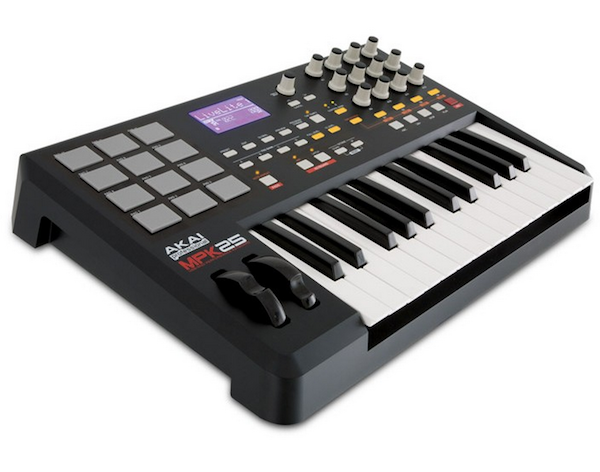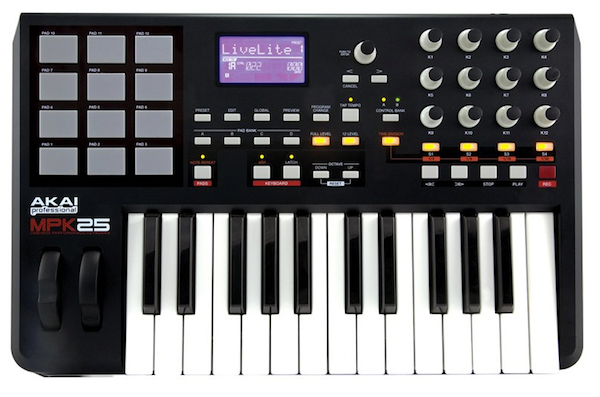M-AUDIO AXIOM 25 MKII VS AKAI MPK25 REVIEW
Posted on Mon 10 October 2011 in entries
 You can read more reviews like this, listen to Tony’s productions, purchase synth patches and more at his personal site -> Tony Long Music.
You can read more reviews like this, listen to Tony’s productions, purchase synth patches and more at his personal site -> Tony Long Music.
AXIOM 25 MKII vs AKAI MPK25 - INTRODUCTION
Here are two USB/MIDI controller keyboards that are small enough to take anywhere, fit into limited spaces in your setup or take on a plane and use on your lap. I therefore thought I would do a comparison between the two and make up my own mind as to which one I would choose.
There are however a good dozen or so 25 note controller keyboards on the current market (ranging from approx. £60 to £250) to cater for the growing number of people that are making music on the move. With such keyboards, the only other things that you need are a laptop and some appropriate software and you have a complete mobile production set-up.
AXIOM 25 MKII vs AKAI MPK25 - CONNECTING UP
Both keyboards are MIDI controllers that transfer MIDI data over USB. They are bus powered and were recognised by my computer without additional drivers in Windows. I simply connected up using the supplied USB cable and they were recognised immediately by my DAW. However, they do both recommend that you should download and install the latest drivers found on their websites.
 ](https://www.absolutemusic.co.uk/akai-mpk25-25-note-controller-keyboard-usb-midi.html)
](https://www.absolutemusic.co.uk/akai-mpk25-25-note-controller-keyboard-usb-midi.html)
AXIOM 25 MKII vs AKAI MPK25 - LOOKS, CONTROLS AND KEYS
The M-Audio Axiom MkII is now a second generation USB MIDI controller keyboard and M-Audio/Avid seem to have really improved on their already successful product. It is well built and chunky, with full size semi-weighted keys. It is larger than M-Audio's own Oxygen 25 key interface. All the controls are solid and feel like they will stand the test of time and heavy usage. I like the idea of the rubber bumper ends, which are moulded into a clever design pattern. I think that better still, the rubber could have protruded a little more to further prevent possible knock damage. This is one of those features (and I must make a list of these one of these days) that I think should be on every keyboard. It is packed with controllers and virtually everything on the Axiom 25 is freely MIDI-assignable.
 ](https://www.absolutemusic.co.uk/m45audio-axiom-25-advanced-25-key-usb-midi-controller-keyboard.html)
](https://www.absolutemusic.co.uk/m45audio-axiom-25-advanced-25-key-usb-midi-controller-keyboard.html)
It has eight good quality pads (and these are just great for programming your drums), eight continuous assignable knobs, transport controls located right above the keys, a good size blue liquid crystal display, great big octave transpose buttons (excellent on a 25-note keyboard), one assignable fader and easily accessible pitch and Modulation wheels.
The keyboard itself is excellent. Although I did find it a little noisy, I thought that this has got to be one of the best actions for this size keybed. Its 25 semi-weighted keys are touch-sensitive with assignable after-touch and they look like piano keys. It is also available in a 49 and 61 key version. It has twenty memory locations and comes with templates for Reason, G-Media, and Oddity etc. It has three zones and three groups. The eight pads can either send note or control information but can also send pressure information. What would be nice is if the transpose buttons worked on the pads but unfortunately they do not.
There are endless possibilities for MIDI assignments here, giving you great control possibilities that will probably satisfy the most advanced of MIDI demands. The Axiom has something called 'DirectLink'. Once installed and configured, DirectLink is activated by launching your DAW and this will automatically map Axiom controls to functions in your DAW.
 ](https://www.absolutemusic.co.uk/m45audio-axiom-25-advanced-25-key-usb-midi-controller-keyboard.html)
](https://www.absolutemusic.co.uk/m45audio-axiom-25-advanced-25-key-usb-midi-controller-keyboard.html)
This is simple but at the same time you can go as deep as you want to. What I really like here is that the Axiom operates in two template driven modes when addressing DAWs. By pressing a single button - the 'Instrument Mode' button, you can switch the 'DirectLink' functionality between 'Mixer' mode (default mode) and 'Instrument' mode whilst the Axiom is controlling your DAW. So, in Mixer mode the Axiom simply controls parameters in your DAW, whilst in Instrument mode the Axiom controls parameters of your VST instruments. The disengaging of this 'DirectLink' functionality leaves the Axiom open to custom MIDI assignments.
OK, so how does this compare with the Akai MPK25? The MPK25 is the little brother of the very popular MPK49 and is of the same solid construction; however, it does not have the benefit of the rubber ends. Again, all of the controls felt good and I was aware straight away that this was a product with a quality build, plus it had more facilities than the Axiom. I found the Akai MPK25 to have a very clever design in that it was packed with controls but it did not feel cramped in any way. It has 12 velocity-sensitive pads and 12 continuous knobs rather than the 8 of the Axiom 25. The pads are also genuine heavy-duty MPC pads, which can also send pressure information and can be programmed over 4 separate banks. I had a go at creating some drum patterns with them and they certainly had the right feel for the job.
The LCD on the MPK25 is good but the one on the Axiom is larger and clearer. Again, it is packed with controls and these are sensibly organised. The octave transpose buttons are much smaller than those of the Axiom.
The MPK is available as a 25, 49, 61 and even a fully-weighted 88 note version. However, I did not like the feel of the keys as much as those on the Axiom. They were of the usual synth-type and were touch-sensitive with assignable after-touch, but they had too much spring back for my playing preferences and so they did not feel natural. This is always the most annoying part for me and I wish manufactures would get this bit right first. With some, it seems they work on the bells and whistles and the keyboard is a bit of an after-thought, as though any 25 note keybed will slot in.
 ](https://www.absolutemusic.co.uk/akai-mpk25-25-note-controller-keyboard-usb-midi.html)
](https://www.absolutemusic.co.uk/akai-mpk25-25-note-controller-keyboard-usb-midi.html)
There are two technologies that came from the MPC series that have been built into the MPK. These are MPC Note Repeat and MPC Swing. MPC Note Repeat enables the MPK to automatically play a rhythm pattern, like fast 16th notes on a hi-hat, whilst MPC Swing injects some human feeling into your music. The note repeat function made it very easy for me to create drum patterns quickly. You may well like the idea of creating the hi-hats continuously, without having to put the notes in individually, but for me, I like the fact that you can take your finger off the note and still have them playing. This produced a more interesting feel with breaks in the hi-hat pulse. By putting the bass and snare beats in first you could let your ears tell you where the breaks in the hi-hat should/could occur.
The MPK25 also has its own arpeggiator and I found this very easy to create riffs with. It also has a Tap Tempo feature with an LED. There are 30 memory locations (10 more than the Axiom) and the first 16 come with useful pre-programmed templates for software including Sonar, Cubase, Reason and Ableton Live Lite etc.
AXIOM 25 MKII vs AKAI MPK25 - SIZE AND WEIGHT
There is not a big difference between the two. The Axiom 25 is slightly heavier at 3.5 kg compared to the Akai MPK25's 3.4kg, but strangely, the Axiom 25 is a little smaller (475 x 296 x 73 mm) compared to the Akai MPK25's size of 477 x 359 x 88mm.
AXIOM 25 MKII vs AKAI MPK25 - CONNECTIONS
The connections seem to be identical. They both have USB, MIDI In and Out, a connection for mains (for if you are not connecting to a computer) and Expression and Sustain Pedal inputs. Annoyingly, as both are powered by USB, there are no mains adaptors included.
AXIOM 25 MKII vs AKAI MPK25 - INCLUDED SOFTWARE
Both keyboards come with Ableton Live Lite, or rather, a link to the Ableton site where you can download Live Lite version 8 and then use the supplied serial number. This will certainly give you an opportunity to have a look at Ableton Live if you haven't done so yet.
For the Axiom, you can also use the free software editor, 'Enigma', that you can download from M-Audio's web site. This is great because it makes the assignment of all the Axiom's controllers, pads and zones even simpler. It also allows you to manage a library of patches should the on-board limit of 20 be insufficient for your needs.
The Akai MPK25 includes 'Vyzek', which is a preset editor and librarian application that gives you a useful interface for your preset-editing tasks. I found that this worked well, allowing banks to be written to and read from my computer.
AXIOM 25 MKII vs AKAI MPK25 - CONCLUSION
This is a strange one for me. Weighing up the evidence, I have to say that the Akai MPK25 wins in the 'additional features' category. I do feel however, that it is slightly let down by its looks in comparison to the M-Audio Axiom and that it is very let down by the playability of its keyboard. The Axiom's attempt to have full piano-like keys is a great idea and whilst it is not the best playing action in the world, when you take into account the type and size of the keyboard, it certainly seems one of the best I have encountered. Therefore, all things considered, the M-Audio Axiom came out slightly on top for me.
So, in the end it was a very difficult choice. Bare in mind that because this was such a close call, I would recommend trying each before you buy, just to be sure that you agree with my conclusions.
For more information on any Axiom or MPK keyboard, click the relevant link below or give us a call on 01202 597180.
M-Audio Axiom 25 - More Info/Buy
M-Audio Axiom 49 - More Info/Buy
M-Audio Axiom 61 - More Info/Buy
******If you're interested in buying and you have seen it cheaper elsewhere, please call us or use our
As well as receiving our first rate customer service you can also claim money off your next purchase with our loyalty points scheme and receive a 3 year warranty if you sign up to our FREE VIP Club (click here for more infomation). Many of our items also come out on a FREE next-day delivery service to mainland UK customers, so you won't be left waiting!
Also, if you want to keep up with all our latest offers, competitions, news and videos, why not follow us on Facebook and Twitter?






